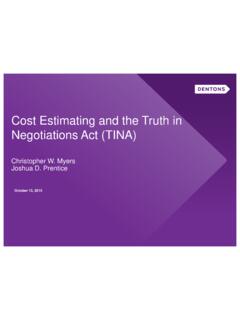Transcription of Guide to information technology security services
1 NIST Special Publication 800-35 Special Publication 800-35 Guide to information technology security services Recommendations of the National Institute of Standards and technology Tim Grance Joan Hash Marc Stevens Kristofor O Neal Nadya Bartol NIST Special Publication 800-35 ii Special Publication 800-35 Guide to information technology security services The National Institute of Standards and technology iii C O M P U T E R S E C U R I T Y October 2003 Department of Commerce Donald L. Evans, Secretary technology Administration Phillip J. Bond, Under Secretary for technology National Institute of Standards and technology Arden L.
2 Bement, Jr., Director Computer security Division information technology Laboratory National Institute of Standards and technology Gaithersburg, MD 20899-8930 NIST Special Publication 800-35 Acknowledgements The authors, Tim Grance and Joan Hash of the National Institute of Standards and technology (NIST), and Marc Stevens, Kristofor O Neal, and Nadya Bartol, of Booz Allen Hamilton (BAH), wish to thank their colleagues who reviewed the many drafts of this document and contributed to its technical content. We also gratefully acknowledge and appreciate the many comments we received from readers of the public and private sectors, whose valuable insights improved the quality and usefulness of this document.
3 The authors would like to specifically acknowledge some key organizations whose extensive feedback substantially contributed to the development of the document. These organizations include: Environmental Protection Agency, Department of Treasury, Tennessee Valley Authority, and Electronic Data Systems. The authors would also like to acknowledge Ron Ross, Gary Stoneburner, Curtis Barker, Ron Tencati, Marianne Swanson, and Bill Burr of NIST, Alexis Feringa, Don Ottinger, Skip Hirsh, and Robert Young, BAH, and Shirley Radack for their extensive review and comment and keen and insightful assistance throughout the development of the document. Any mention of commercial products or reference to commercial organizations is for information only; it does not imply recommendation or endorsement by NIST nor does it imply that the products mentioned are necessarily the best available.
4 I NIST Special Publication 800-35 Executive Summary Organizations frequently must evaluate and select a variety of information technology (IT) security services in order to maintain and improve their overall IT security program and enterprise architecture. IT security services , which range from security policy development to intrusion detection support, may be offered by an IT group internal to an organization, or by a growing group of vendors. Organizations can benefit when choices among services and service providers stimulate competition and bring innovation to the marketplace. However, it is difficult and challenging to determine service provider capabilities, measure service reliability and navigate the many complexities involved in security service agreements.
5 Individuals who are responsible for selecting, implementing, and managing IT security services for an organization must carefully evaluate their options before selecting resources that will be entrusted to meet their particular IT security program requirements. The factors to be considered when selecting, implementing, and managing IT security services include: the type of service arrangement; service provider qualifications, operational requirements and capabilities, experience, and viability; trustworthiness of service provider employees; and the service provider s capability to deliver adequate protection for the organization systems, applications, and information .
6 These considerations will apply (to varying degrees) to every service depending on the size, type, complexity, cost, and criticality of the services being considered and the specific needs of the organization implementing or contracting for the services . The Guide to information technology security services , Special Publication 800-35, provides assistance with the selection, implementation, and management of IT security services by guiding organizations through the various phases of the IT security services life cycle. This life cycle provides a framework that enables the IT security decision makers to organize their IT security efforts from initiation to closeout.
7 The systematic management of the IT security services process is critically important. Failure to consider the many issues involved and to manage the organizational risks can seriously impact the organization. IT security decision makers must think about the costs involved and the underlying security requirements, as well as the potential impact of their decisions on the organizational mission, operations, strategic functions, personnel, and service provider arrangements. The six phases of the IT security life cycle are: Phase 1: Initiation the organization determines if it should investigate whether implementing an IT security service might improve the effectiveness of the organization s IT security program.
8 Phase 2: Assessment the organization determines the security posture of the current environment using metrics and identifies the requirements and viable solutions. Phase 3: Solution decision makers evaluate potential solutions, develop the business case and specify the attributes of an acceptable service arrangement solution from the set of available options. Phase 4: Implementation the organization selects and engages the service provider, develops a service arrangement, and implements the solution. Phase 5: Operations the organization ensures operational success by consistently monitoring service provider and organizational security performance against identified requirements, periodically evaluating changes in risks and threats to the organization and ensuring the organizational security solution is adjusted as necessary to maintain an acceptable security posture.
9 Phase 6: Closeout the organization ensures a smooth transition as the service ends or is discontinued. ii NIST Special Publication 800-35 This Guide describes a life cycle that provides a context to assist organizations with managing the myriad issues surrounding IT security services . However, the Guide does not prescribe or recommend any specific IT security service, IT security service arrangement, IT security service agreement, or IT security service provider. Each organization must perform its own analysis of its needs and assess, select, implement, and oversee the IT security service to best address its needs. The Guide should be used in conjunction with other NIST Special Publications (SP) that focus on procurement of IT systems, including NIST SP 800-64, security Considerations in the information System Development Life Cycle, and NIST SP 800-36: Guide to Selecting information technology security Products.
10 NIST SP 800-55, security Metrics Guide for information technology Systems will help organizations understand the importance of using metrics and developing a metrics program. Other NIST special publications may be helpful in providing information on specific services and technologies. These include: SP 800-30: Risk Management Guide for information technology Systems SP 800-32: Introduction to Public Key technology and the Federal PKI Infrastructure SP 800-33: Underlying Technical Models for information technology security SP 800-34: Contingency Planning for information technology Systems SP 800-41: An Introduction to Firewalls and Firewall Policy SP 800-42: Guideline on Network security Testing SP 800-48: Wireless Network security : , Bluetooth, and Handheld Devices SP 800-50: Building an information technology security Awareness and Training Program SP 800-53.











